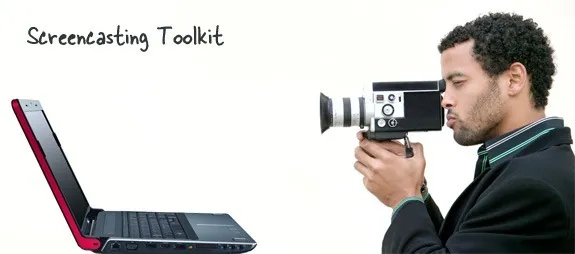A screencast is essentially a movie of your computer screen that is often used to demonstrate how specific features of a software are used. Good screencast videos are short in length, they have audio - either as voice narration or in the form of background music - and they may also include some sort of notes or text transcripts to aid the viewers.
The Best Tools for Creating Screencasting
Screencasting is an easy thing to do but unless your screencast videos are done well, it is unlikely that people will watch them past the first few seconds. Here are some of the best software tools and hardware devices that can help you create professional-quality screencasts with a bit of planning and effort.
Step 1. Prepare the stage.
Get a good-looking theme and a clean background wallpaper for your desktop because the first frame matters. I like the collection available on microsoft.com – it’s meant for Windows 7 but you may also install them on older versions of Windows as well.
Turn off the fans in the room as your microphone can easily pick that sound. Use a tool like SmartClose to kill all the software programs running on your desktop since you don’t want an email message or an IM notification to pop-up while recording a screencast. Also hide all the desktop icons since they may distract the viewer.
If there are certain important programs running on the desktop that you cannot afford to close for the screencast, simply use a virtual desktop manager and start recording on a new ‘virtual’ screen.
Step 2. Lights, camera, action.
Your screencast may either involve a single program or multiple programs in which you case you’ll have to switch between windows during the recording. If you are recording with just one window, use the Sizer utility to ensure that the window fills the entire recorded space. In the case of multiple windows, you may either use Project Window or WinSize2 to quickly switch between windows.
Next you need a tool for recording screencasts.
I mostly use Camtasia Studio to record all my video screencasts but Expression Encoder from Microsoft, Jing and BB Flashback are other good alternatives that are completely free. You may also record screencasts from the browser using a web-based screencasting app like Screenr.
If you are creating screencasts of video games or OpenGL apps like Google Earth, the free WeGame client is a good option or, for better quality, you may consider FRAPS.
Screencast is often done in an offline environment and after the video is edited, it is uploaded online for everyone else to see and download. However, if you plan to do some live screencasting where your desktop is streamed live over the Internet, Procaster and Join.me are good choices.
Step 3. Good audio makes all the difference.
I record the video first and then add the audio narration later.
If you are working on a short 30-second video, you probably don’t need enough planning but for everything else, it will help if you can script the entire workflow. These handy PDF templates can help you plan and script screencasts, scene by scene while you may use a software-based teleprompter for flawless narrations.
Audacity is obviously the best software for recording and editing sounds for your screencasts but for good audio, you also need a good microphone. I have been using a Samson C01U microphone for the past few years but I were to buy one today, my choices would be either the Blue Yeti microphone or Audio-Technica AT2020 – these are all desktop-based condenser microphones that connect to the computer over USB.
If you don’t have enough space at your workplace or need something more portable, Samson Go Mic is a good choice as it clips to the edge of your laptop /computer monitor.
Other than voice narration, some soft background music can make your screencasts more appealing. Sound Cloud, MySpoonful, ccMixter, Archive.org and Free Music Archive are some good sites on the Internet from where you can download free and legal music to go with your screencast videos.
Step 4. Personalize screencast with video.
It may sometimes be a good idea to include a short video of your own self in the screencast as your audience will connect better when they get to see the person working behind the scene.
You have two options here – you can either use the built-in VGA webcam of your laptop and drive away audience or use a good-quality video camera to deliver crisp HD-quality video. I am a huge fan of Kodak Zi8 video camera (the Life in a Day video was recorded using a Zi8) though the new Flip MinoHD and Flip UltraHD models are no less impressive.
One downside with these HD video cameras is that they cannot be used as substitute for a webcam because they can’t record while connected to the computer. If you need to record your computer screen and your own video simultaneously, go with an HD webcam like the Logitech C910 (1080p) or the Lifecam Cinema from Microsoft that records at 720p.
Step 5. Lift the curtains.
Now that your screencast is ready, you need to decide on the delivery1 mechanism.
The easiest option is that you upload your screencast video to YouTube.com2 – the service will automatically encode the video in multiple formats so that your screencast can be watched on mobile phones, desktops and tablet devices like the iPad. If you want more exposure for your screencasts, consider them uploading to multiple sites with the help of services like TubeMogul.
If you are producing screencasts on a regular bases, one additional distribution channel that you can explore is iTunes. Apple maintains a popular podcast directory and it makes sense to have your video screencasts as a separate podcast shows there.
The Apple website has additional details on how you can submit and distribute podcasts through iTunes. You’ll need a web server to host your screencast video files but if you don’t have one, just use Blip.tv – it takes care of the hosting as well the RSS feed.
[1] See related guide: How to Make 720p HD Screencasts for YouTube.
[2] Tiny screencasts, 15 seconds or less, may also be served as animated GIF instead of video.



